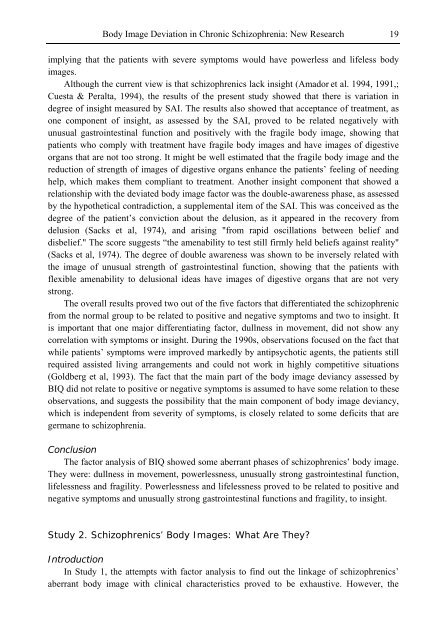Schizophrenia Research Trends
Schizophrenia Research Trends
Schizophrenia Research Trends
- No tags were found...
Create successful ePaper yourself
Turn your PDF publications into a flip-book with our unique Google optimized e-Paper software.
Body Image Deviation in Chronic <strong>Schizophrenia</strong>: New <strong>Research</strong> 19implying that the patients with severe symptoms would have powerless and lifeless bodyimages.Although the current view is that schizophrenics lack insight (Amador et al. 1994, 1991,;Cuesta & Peralta, 1994), the results of the present study showed that there is variation indegree of insight measured by SAI. The results also showed that acceptance of treatment, asone component of insight, as assessed by the SAI, proved to be related negatively withunusual gastrointestinal function and positively with the fragile body image, showing thatpatients who comply with treatment have fragile body images and have images of digestiveorgans that are not too strong. It might be well estimated that the fragile body image and thereduction of strength of images of digestive organs enhance the patients’ feeling of needinghelp, which makes them compliant to treatment. Another insight component that showed arelationship with the deviated body image factor was the double-awareness phase, as assessedby the hypothetical contradiction, a supplemental item of the SAI. This was conceived as thedegree of the patient’s conviction about the delusion, as it appeared in the recovery fromdelusion (Sacks et al, 1974), and arising "from rapid oscillations between belief anddisbelief." The score suggests “the amenability to test still firmly held beliefs against reality"(Sacks et al, 1974). The degree of double awareness was shown to be inversely related withthe image of unusual strength of gastrointestinal function, showing that the patients withflexible amenability to delusional ideas have images of digestive organs that are not verystrong.The overall results proved two out of the five factors that differentiated the schizophrenicfrom the normal group to be related to positive and negative symptoms and two to insight. Itis important that one major differentiating factor, dullness in movement, did not show anycorrelation with symptoms or insight. During the 1990s, observations focused on the fact thatwhile patients’ symptoms were improved markedly by antipsychotic agents, the patients stillrequired assisted living arrangements and could not work in highly competitive situations(Goldberg et al, 1993). The fact that the main part of the body image deviancy assessed byBIQ did not relate to positive or negative symptoms is assumed to have some relation to theseobservations, and suggests the possibility that the main component of body image deviancy,which is independent from severity of symptoms, is closely related to some deficits that aregermane to schizophrenia.ConclusionThe factor analysis of BIQ showed some aberrant phases of schizophrenics’ body image.They were: dullness in movement, powerlessness, unusually strong gastrointestinal function,lifelessness and fragility. Powerlessness and lifelessness proved to be related to positive andnegative symptoms and unusually strong gastrointestinal functions and fragility, to insight.Study 2. Schizophrenics’ Body Images: What Are They?IntroductionIn Study 1, the attempts with factor analysis to find out the linkage of schizophrenics’aberrant body image with clinical characteristics proved to be exhaustive. However, the
















